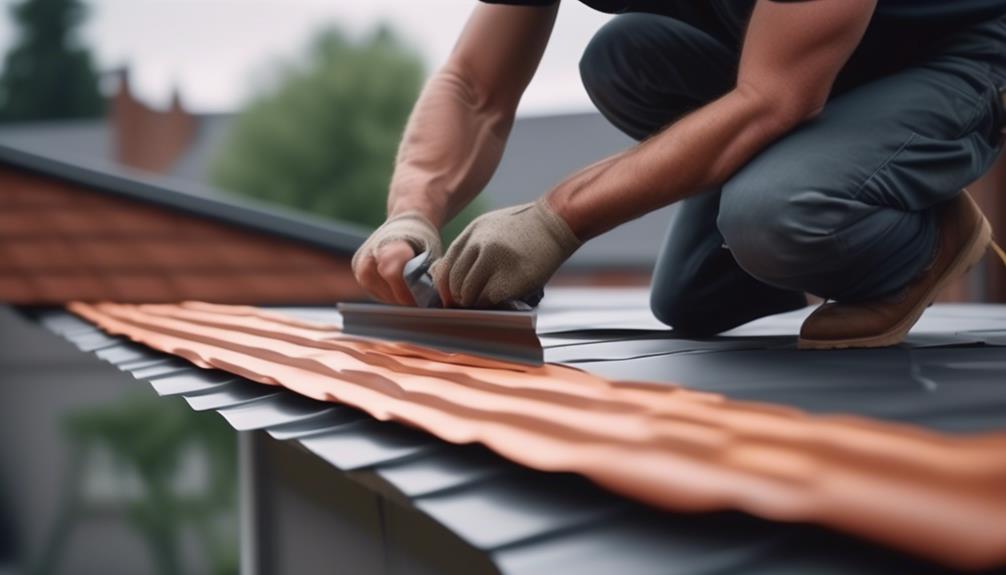When it comes to installing roof flashing for flat roofs, there are several crucial steps to follow. We'll guide you through the process, from choosing the right material to sealing and finishing the installation.
But why is proper roof flashing installation so important for flat roofs? Well, it not only protects your home from potential water damage but also ensures the longevity and durability of your roof.
So, let's get started and uncover the step-by-step process that will leave your flat roof well-protected and worry-free.
Choosing the Right Roof Flashing Material
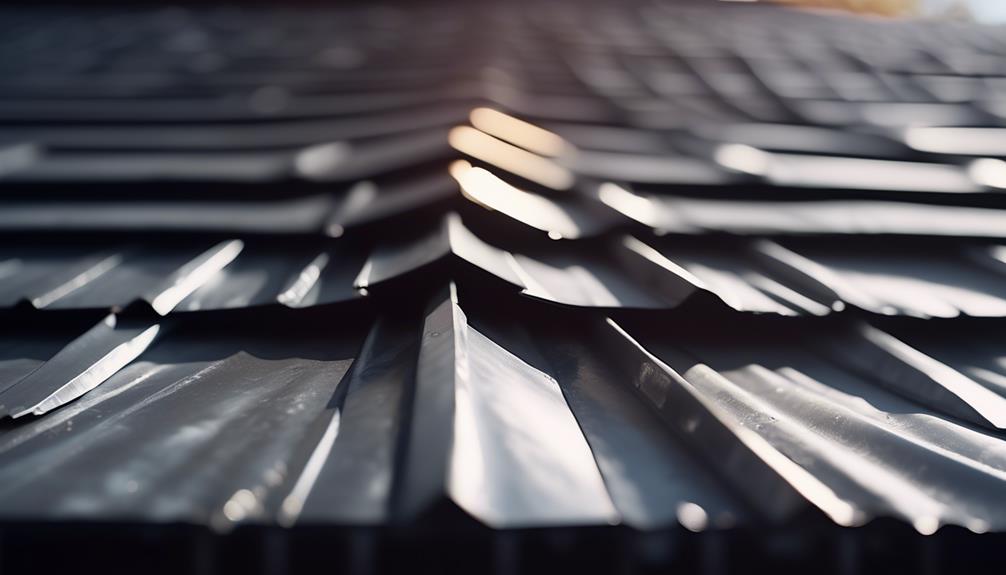
When choosing the right roof flashing material, it's important to consider factors such as durability, weather resistance, and compatibility with the roofing material. There are different types of roof flashing materials available, each with its own pros and cons.
One common type of roof flashing material is galvanized steel. This material is known for its durability and strength, making it a popular choice among homeowners and professionals alike. Galvanized steel is resistant to corrosion, ensuring that it will last for a long time even in harsh weather conditions. However, it can be prone to rusting over time, especially if it isn't properly maintained.
Another option is aluminum flashing. Aluminum is lightweight, making it easier to work with during installation. It's also resistant to corrosion, making it a good choice for areas with high moisture levels. However, aluminum flashing may not be as strong as other materials, which can be a drawback in areas with heavy snow or strong winds.
Copper flashing is another option to consider. It's known for its aesthetic appeal, as it develops a natural patina over time. Copper is also durable and resistant to corrosion, making it a long-lasting choice. However, copper flashing tends to be more expensive compared to other materials, which can be a disadvantage for those on a tight budget.
Assessing the Flat Roof for Flashing Installation
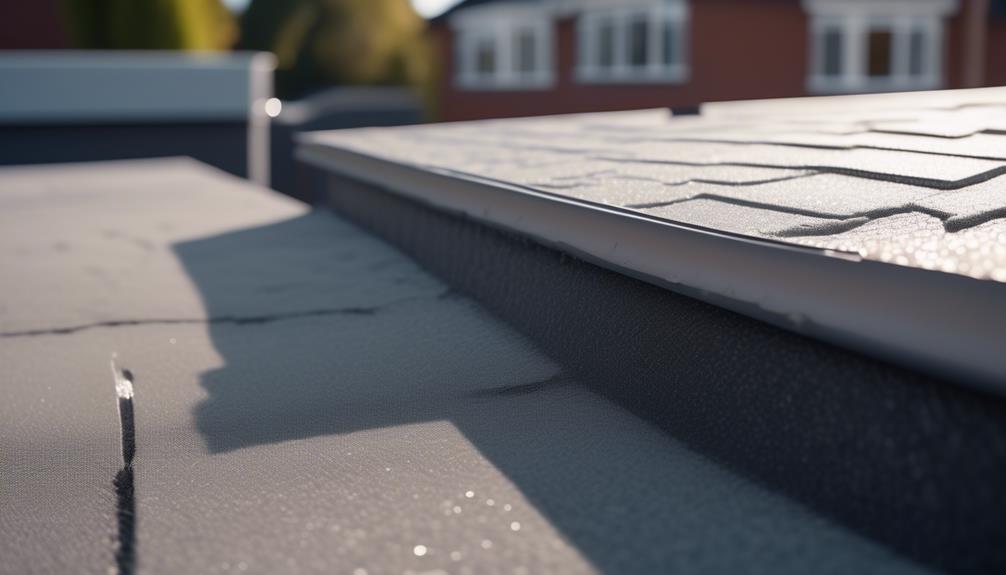
Now that we've considered the different types of roof flashing materials, it's essential to assess the flat roof to determine the appropriate installation process. Before proceeding with the flashing installation, it's crucial to inspect the roof condition and identify any potential flashing issues.
Here are some key points to consider during the assessment:
- Inspecting roof condition: Take a thorough look at the flat roof to identify any signs of damage or deterioration. Look for cracks, leaks, or sagging areas that may require repairs before installing the flashing. It's important to ensure that the roof is in good condition to provide a solid foundation for the flashing installation.
- Identifying potential flashing issues: Pay close attention to areas where the flashing will be installed, such as around vents, chimneys, or skylights. Look for signs of previous flashing damage, such as rust, corrosion, or loose connections. Identifying these issues beforehand will help determine the proper approach for installing the new flashing.
- Evaluate the roofing material: Different roofing materials require different flashing techniques. Assess the type of roofing material used on the flat roof, such as asphalt, EPDM, or TPO, and consider how the flashing should be integrated to ensure a watertight seal. Understanding the compatibility between the roofing material and flashing is crucial for a successful installation.
- Consider climate factors: Take into account the climate conditions in your area. Extreme temperatures, heavy rainfall, or high winds can impact the effectiveness of the flashing. Assess whether additional measures, such as extra sealant or reinforcement, are necessary to enhance the flashing's durability and longevity.
Preparing the Roof Surface for Flashing
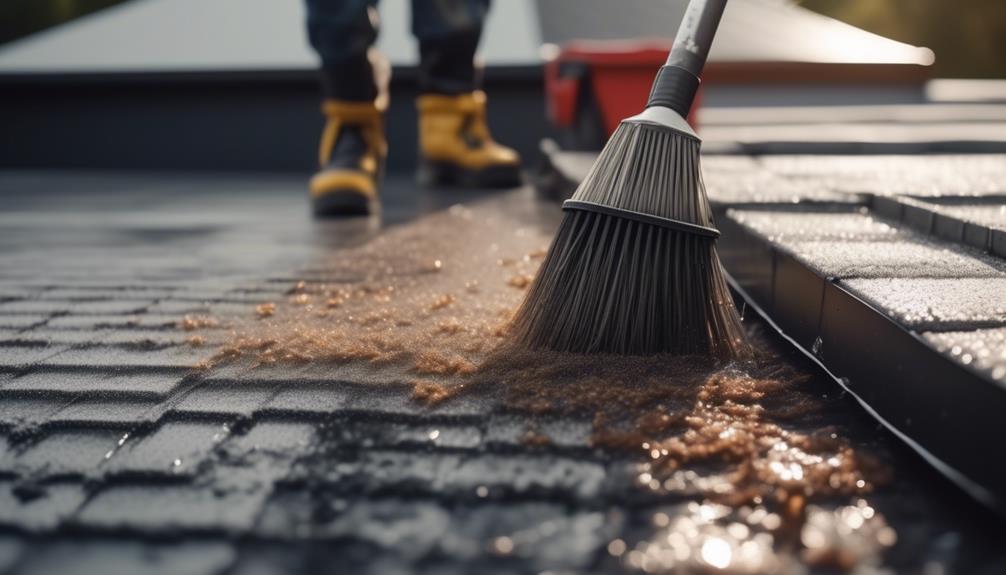
Before installing the flashing on a flat roof, it's crucial to properly prepare the roof surface. The first step is to clean the roof surface thoroughly, removing any debris, dirt, or loose materials. This will ensure a clean and smooth surface for the flashing to adhere to.
Next, it's important to apply a primer coat to the roof surface, which will enhance the adhesion of the flashing material and provide additional protection against leaks.
Clean Roof Surface
To prepare the roof surface for flashing, we recommend thoroughly cleaning the area using a suitable cleaning solution and a stiff bristle brush. This step is crucial for ensuring proper adhesion and longevity of the flashing material.
Here are some key points to consider when cleaning the roof surface:
- Use a gentle cleaning solution that's specifically designed for roof cleaning. Avoid harsh chemicals that can damage the roof surface.
- Start by removing any loose debris, such as leaves, twigs, and dirt, using a broom or a leaf blower.
- Apply the cleaning solution onto the roof surface and let it sit for a few minutes to loosen any stubborn stains or algae growth.
- Scrub the roof surface using a stiff bristle brush, making sure to apply enough pressure to effectively remove dirt and grime.
Apply Primer Coat
To properly prepare the roof surface for flashing, it is essential to apply a primer coat in order to ensure optimal adhesion and a secure installation. The primer coat acts as a bonding agent between the roof surface and the flashing material, enhancing the overall durability and longevity of the installation. Applying the primer coat requires careful attention to detail and adherence to specific techniques.
Here are some important primer application techniques to keep in mind:
| Technique | Description |
|---|---|
| Clean and Dry Surface | Before applying the primer, ensure that the roof surface is clean and free from any debris or moisture. This will promote better adhesion and prevent any potential issues in the future. |
| Proper Mixing | Follow the manufacturer's instructions and mix the primer thoroughly to ensure a consistent and uniform application. |
| Application Method | Use a brush or roller to apply the primer evenly on the roof surface. Pay special attention to the edges and corners where the flashing will be installed. |
| Drying Time | Allow the primer coat to dry completely before proceeding with the installation. This usually takes around 24 hours, but it may vary depending on the specific product and weather conditions. |
The importance of applying a primer coat cannot be overstated. It creates a strong bond between the roof surface and flashing, preventing water infiltration and ensuring the longevity of the installation. By following proper primer application techniques, you can ensure a secure and reliable flat roof flashing system.
Installing the Base Flashing
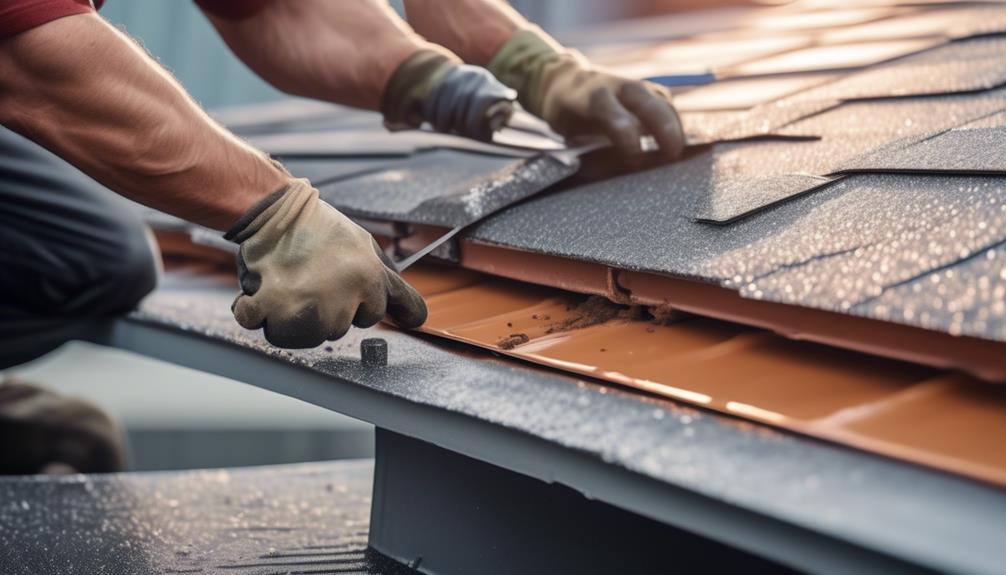
Now let's focus on the important points for installing the base flashing.
First, we need to measure the dimensions of the roof to determine the size of the flashing needed.
Next, we should prepare the flashing material by cutting it to the appropriate size and shape.
Measure Roof Dimensions
We will now proceed with the crucial step of measuring the dimensions of the roof in order to install the base flashing for a flat roof. To accurately calculate measurements, follow these steps:
- Use a tape measure to determine the length and width of the roof surface.
- Measure the height of any parapet walls or other structures adjacent to the roof.
- Note the locations of any protrusions, such as vents or skylights, and measure their dimensions as well.
- Take into account any slopes or angles present on the roof surface.
Once you have calculated the measurements, it's time to source the necessary materials. Consider the following:
- Purchase base flashing material that's compatible with your roof type and weather conditions.
- Ensure you have the appropriate tools for installation, such as a utility knife, roofing cement, and fasteners.
Prepare Flashing Material
Before installing the base flashing, it's essential to properly prepare the flashing material according to the specifications of your flat roof. Choosing appropriate materials is crucial for a successful installation. The most common type of flashing material for flat roofs is aluminum, due to its durability and resistance to corrosion. However, other options like PVC or EPDM can also be used, depending on your specific needs.
To prepare the flashing material, start by measuring and cutting it to the required dimensions. Make sure to account for any overlaps or bends that may be necessary. Next, clean the surface of the material to remove any dirt or debris that could interfere with the adhesion process.
When it comes to installation techniques, follow the manufacturer's instructions closely. Apply an appropriate adhesive or sealant to ensure a watertight seal. It's also essential to secure the flashing material firmly in place using screws or nails, as specified by the manufacturer.
Secure Flashing in Place
To securely install the base flashing, it's crucial to follow proper techniques and ensure a tight seal for optimal water resistance. Here are the steps to anchor the flashing and prevent leaks:
- Step 1: Position the base flashing at the desired location on the roof, ensuring it overlaps the roof membrane by at least 4 inches.
- Step 2: Use roofing screws or nails to secure the flashing in place, making sure to drive them through the pre-drilled holes in the flashing.
- Step 3: Apply a generous amount of roofing sealant along the edges of the flashing to create a watertight seal.
- Step 4: Press down firmly on the flashing to ensure it's securely adhered to the roof surface.
Applying the Step Flashing
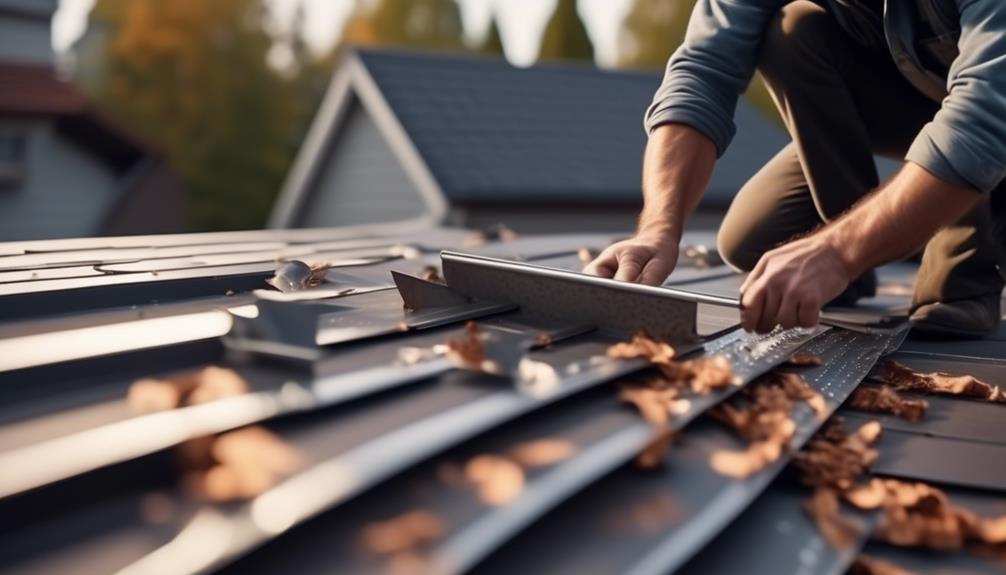
When applying the step flashing for flat roofs, it's essential to ensure a secure and watertight installation. Step flashing is an integral component of the roof flashing system, designed to protect vulnerable areas where the roof meets vertical structures such as walls or chimneys. Properly applied step flashing prevents water infiltration and helps maintain the integrity of the roof.
To begin, it's crucial to use the correct size and material of step flashing. Typically, step flashing is made from galvanized steel or aluminum, which provides durability and resistance to corrosion. The flashing should be cut into sections that are approximately 8 to 10 inches wide, with a height that extends at least 3 inches above the shingle.
Next, the step flashing should be installed in a shingle-underlayment pattern, overlapping each piece to ensure a watertight seal. This technique involves sliding each piece of flashing under the shingle above it, starting from the bottom and working our way up. The flashing should be fastened securely to the vertical structure using nails or screws, ensuring it's flush against the surface.
During the installation process, it's important to pay attention to potential flashing issues that may arise. Common troubleshooting problems include improper alignment, inadequate overlap, or gaps between the flashing and the vertical structure. These issues can compromise the effectiveness of the flashing system, leading to water leaks and potential damage to the roof and interior of the building.
Sealing and Finishing the Flashing Installation
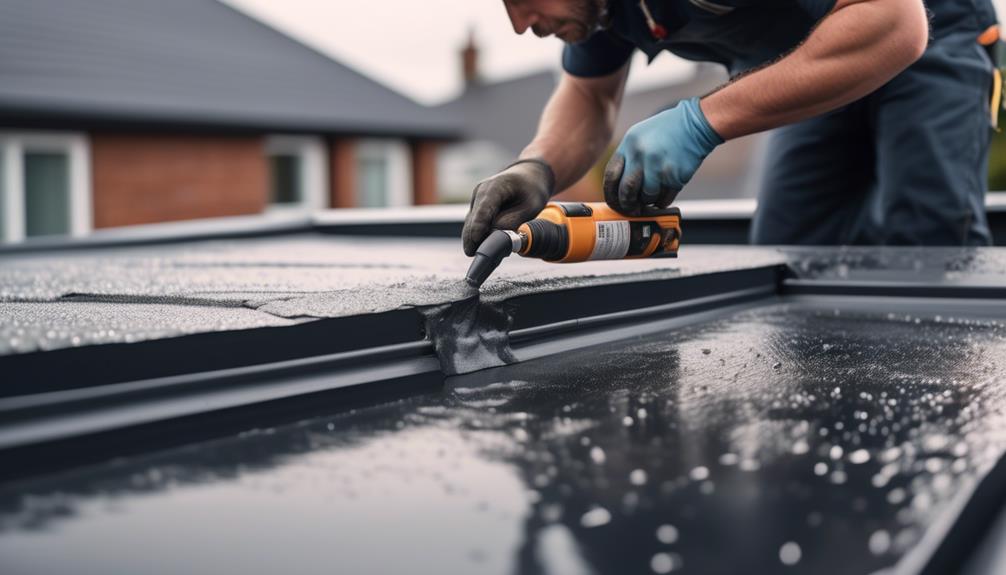
For a secure and watertight installation, it's important to properly seal and finish the flashing installation on a flat roof. The finishing techniques used can greatly impact the longevity and effectiveness of the flashing. Here are some common mistakes to avoid and tips for achieving a professional finish:
- Use the right sealant: Choose a high-quality sealant that's specifically designed for roofing applications. Silicone or polyurethane sealants are often recommended for their durability and flexibility.
- Apply sealant generously: Ensure that you apply an ample amount of sealant along the edges and joints of the flashing. This will help create a watertight barrier and prevent any potential leaks.
- Smooth out the sealant: After applying the sealant, use a putty knife or a caulk gun with a smoothing tool to create a smooth and even finish. This won't only improve the aesthetics but also enhance the sealant's performance.
- Inspect for gaps and cracks: Once the sealant has dried, carefully inspect the flashing for any gaps or cracks. These can compromise the effectiveness of the seal and lead to water infiltration. If any issues are found, promptly reapply sealant to fill in the gaps.
Frequently Asked Questions
How Long Does Roof Flashing Typically Last Before Needing to Be Replaced?
On average, roof flashing typically lasts around 20 to 30 years before needing replacement. However, the lifespan can be influenced by various factors such as climate conditions and the quality of installation.
Signs of deterioration may include rust, cracks, or loose flashing. It's essential to regularly inspect your roof flashing for any signs of wear and tear to ensure proper protection against water damage.
Timely replacement of deteriorated flashing is crucial to maintain the integrity of your flat roof.
Can I Install Roof Flashing on My Own, or Do I Need to Hire a Professional?
When it comes to installing roof flashing, the decision between DIY or hiring a professional is a crucial one.
While attempting it ourselves may seem feasible, it's important to weigh the advantages and disadvantages.
DIY installation allows for cost savings and a sense of accomplishment, but it requires technical knowledge and the right tools.
On the other hand, hiring a professional ensures expertise and guarantees a job well done, but it can be more expensive.
Ultimately, the choice depends on your level of skill and comfort with the task at hand.
Are There Any Specific Safety Precautions I Should Take When Installing Roof Flashing?
When installing roof flashing, it's crucial to prioritize safety. Always wear protective gear, such as gloves and safety goggles, to prevent injuries. Use sturdy ladders or scaffolding to access the roof safely.
Make sure to have the necessary tools and equipment, such as a hammer, roofing nails, and a pry bar, before starting the installation process. Additionally, be mindful of the weather conditions and avoid working on a flat roof when it's wet or icy to prevent slips and falls.
Can Roof Flashing Be Installed on Any Type of Flat Roof, or Are There Certain Materials That Are Not Compatible?
When it comes to roof flashing for flat roofs, it's crucial to understand the compatibility of different roofing materials. Proper installation techniques are of utmost importance.
We need to ensure that the materials used for the roof flashing are compatible with the specific type of flat roof. This will ensure the longevity and effectiveness of the flashing in preventing water penetration.
It's vital to follow the guidelines to achieve a successful installation.
How Do I Know if My Roof Is in Need of New Flashing, and What Are the Signs of Flashing Failure?
When it comes to roof flashing, it's crucial to know the signs of damage and failure. If you notice water leaks, mold growth, or stains on your ceiling, it could indicate a problem with the flashing.
Proper installation of flashing is essential to prevent these issues. By ensuring the flashing is correctly installed, you can protect your roof and home from water damage.
Regular inspections and maintenance can help identify any flashing problems early on.
